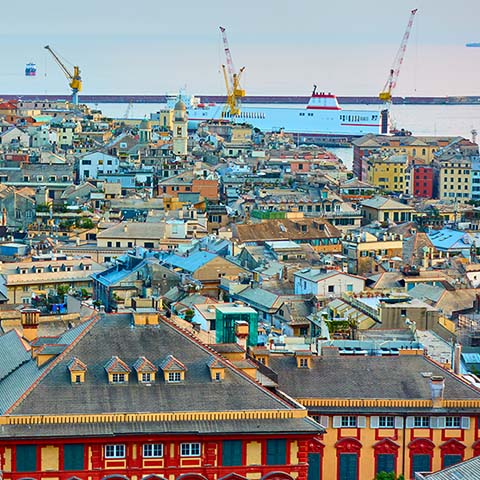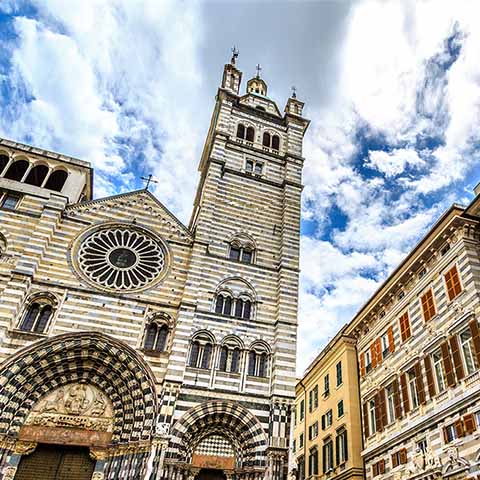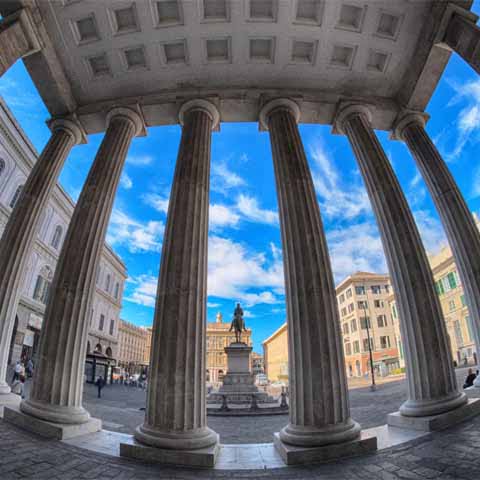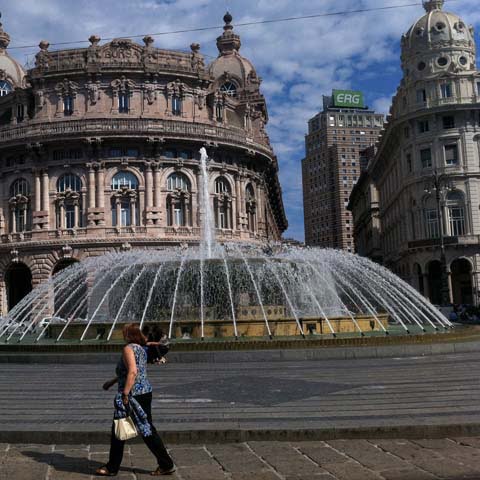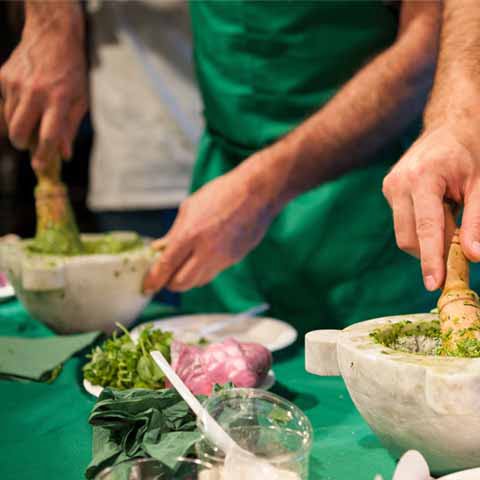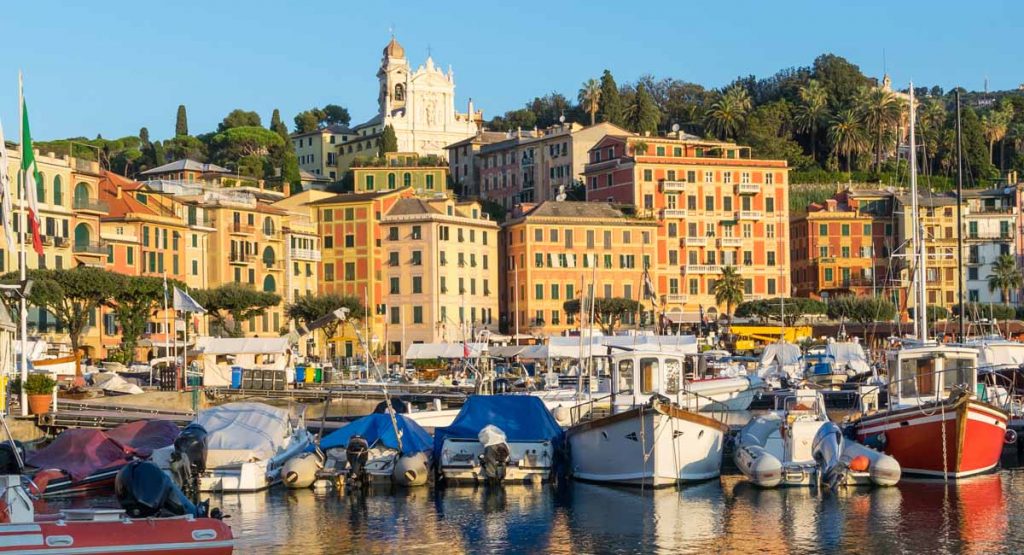Genoa’s culture is full of history and tradition. From the rocky terrain of the Ligurian Alps to the majestic waters of the Ligurian Sea, visitors can learn and experience the city’s deep cultural roots in education, the arts, science and architecture. These roots are what led to its honorable designation as the 2004 European Capital of Culture.
Genoa is the birthplace of many notable historic figures including the House of Grimaldi’s founder – Grimaldo Canella – as well as Giuseppe Mazzini, Andrea Doria, and well-known explorer Christopher Columbus. Travelers from all over the world congregate at the reconstructed site of his birth, the House of Columbus. Located near Porta Sobrano, the quaint house is a public museum dedicated to Columbus’ dynamic life.
Historically, Genoa has been at the forefront of economic and naval leadership. Nicknamed “the Proud One,” or la Superba, the city has seen its share of obstacles and defeats, yet each left a cultural impression on the area. From the historic landmarks to the industrial port area, the city has always been one to admire for its resilience and hard-working atmosphere. Evidence of this is present in the historic and modern-day cultural opportunities that visitors can experience.
One longstanding constant in the area’s culture is the higher education prospects available. As early as the 13th century, education had an importance in this Northern Italy city. At the center of it all is one of the country’s biggest universities – the University of Genoa. Educational diversity is evident in the schools available, including: the Italian Institute of Technology, the Niccolò Paganini Conservatory, and the Italian Hydrographic Institute.
Genoa’s historic city center, a UNESCO World Heritage Site since 2006, is one of the largest in the country. Included in the site are the Strada Nuove (Via Giuseppe Garibaldi, Via Cairoli, Via Bensa, and Via Balbi), which were created by the aristocracy during the sixteenth and seventeenth centuries, the peak of the Republic of Genoa. Forty-two of the Palazzi dei Rolli, which are among the most elegant noble buildings in Genoa, are also part of the official site listing. During the Republic of Genoa, a lottery would take place to determine which private noble residences would host diplomatic guests to the Republic. The palaces became known as Palazzi dei Rolli (Palaces of the Lists). Nowadays, all of the Rolli Palaces, both public and private, are open to visitors on special Rolli Days that occur at different points of the year (typically in April and October).
Thanks to its illustrious past, Genoa is a city of elegance that has made significant contributions to the fields of art, architecture, literature, cinema, science, and music.
ART IN GENOA
As with many Italian cities, Genoa has an abundance of art to enjoy. Visitors can take in the beauty of the numerous Renaissance, Baroque, and Rococo frescoes found in the palaces and churches throughout the city. Of particular interest are the breathtaking paintings within the Genoa Cathedral, including Crucifixion with Saints by Federico Barocci and Assumption of the Virgin by Gaetano Previati. Sculptures such as St. John the Baptist by Andrea Sansovino and stunning fourteenth century Byzantine frescoes are on display inside the church as well.
While the exteriors of the city’s villas and palaces tend to be rather simple architecturally, with a few exceptions of course, the interiors are intricately decorated with beautiful artwork and tapestries that can be seen hanging throughout the grand rooms and hallways.
For a more in-depth art experience, travelers can visit one of the many art museums or galleries. Among these is the Palazzo Ducale or Doge’s Palace, which is located in the very heart of the historical city center. Completed in 1339, the palace served as the seat of the Doge, the historic ruler of Genoa until the end of the Republic of Genoa in 1815. The building suffered damage during World War II bombing, but was restored in 1992, as part of the restructuring that occurred throughout the city in honor of the 500th anniversary of Christopher Columbus’s discovery of the Americas. As part of its more recent history, the palace hosted the G8 summit in 2001. Today the palace is a museum and serves as one of the main cultural hubs of the city. During a visit to the museum, travelers can admire ornately decorated rooms and halls including the Doge’s apartment, the Doge’s chapel, and the council rooms. From the ceilings to the floors of the palace, there is art everywhere you look including stunning chandeliers, marble floors, frescoes, paintings, and more.
Another of Genoa’s most important palaces is the Palazzo Reale, or Royal Palace. Constructed in the seventeenth century, the palace was owned by several powerful families beginning with the Balbi family and ending with the House of Savoy. Today, this elegant palace is a museum and it still retains many original decorations and furniture pieces. It is renowned for its frescoes by artists such as Andrea Sghizzi and Valerio Castello as well as paintings by Tintoretto, Luca Giordano, Anthony van Dyck, Guercino, and more.
Palazzo Doria-Tursi is one of the most important Rolli Palaces. Located on Via Garibaldi, the palace has served as the seat of Genoa’s city hall since the mid-nineteenth century. Today, it is part of the Strada Nuova Museum complex together with two other Rolli Palaces: Palazzo Rosso and Palazzo Bianco. The traditional route through the complex begins in Palazzo Rosso where travelers can admire paintings from the fifteenth to the twentieth centuries. Palazzo Bianco is next, and it houses notable works by local Genoese and Ligurian painters as well as national and international artists from Spain and Belgium. The visit concludes in Palazzo Doria-Tursi with the Paganini collection and Antonio Canova’s masterful sculpture Penitent Magdalene.
Palazzo Spinola is another grand gallery located in Genoa. This former noble residence dates back to the sixteenth century and was constructed in the Mannerist style. Of particular renown are the marvelous frescoes located in the building’s atrium
The Galleria d’Arte Moderna, also known as GAM, is Genoa’s principal modern art gallery. Located in the Nervi neighborhood, the core pieces of the collection were donated by the House of Savoy in the nineteenth century. The building that houses the museum, known as Villa Saluzzo Serra, dates back to the seventeenth century. The museum hosts approximately 350 artworks spanning from the nineteenth century to the present day. The collection features paintings, sculptures, and drawings with a focus on local artists, such as Nicolò Barabino, though national and international artists, such as Renato Guttuso and Zao Wou-Ki are represented as well.
Another of Genoa’s fascinating museums is the Giannettino Luxoro Museum. Also found in the Nervi neighborhood, this museum hosts a collection of seventeenth- and eighteenth-century paintings, ceramics, and furniture as well as unique nativity figures. Among the paintings, travelers can admire works by members of the Genoese school, such as Alessandro Magnasco.
ARCHITECTURE
The diverse architecture of Genoa is visible in the stunning buildings visitors will find throughout their stay, starting with the ancient city walls that still stand. The styles of Art Nouveau, Gothic Revival, Renaissance, Romanesque, and Neoclassical are all represented. Whether it is the exquisite altars and the detailed portals and facades, or the materials they are constructed of such as wrought iron, marble, and steel – the structural landscape of Genoa is one of a kind.
The 1980s and 1990s were a time of restoration for the city when buildings that were destroyed during World War II, including Teatro Carlo Felice and the Doge’s Palace, were brought back to life. Architect Renzo Piano wanted to contribute to the cause, and in doing so restored the historic buildings of the Old Port while creating new sites as well. The three main structures he created are the innovative Aquarium, (the largest in Italy), the Bigo, which is a panoramic elevator, and a giant sphere of metal and glass, called La Biosfera (the Biosphere), which hosts an ecosystem of tropical plants, butterflies, and small creatures. Each of these structures was designed in a modern style with important symbolism. In particular, the Aquarium was designed to resemble a ship about to depart for the sea, while the Bigo elevator looks like a crane ready to unload goods that arrive in the port.
The modern buildings of the Old Port are fascinating, but they comprise only a part of Genoa’s fascinating cityscape.
Among the more historic buildings, arguably the most important is the Cathedral of San Lorenzo. One of the oldest churches in the city, the original structure dates back to the early eleventh century. Dedicated to Saint Laurence, the cathedral is renowned for housing the ashes of St. John the Baptist, the Patron Saint of Genoa, which were brought to the city following the First Crusade. The original structure is Romanesque, though after a devastating fire at the end of the thirteenth century it was partially rebuilt in the Gothic style. The characteristic black and white striped façade dates back to the early fourteenth century. The fourteenth and fifteenth century were a period of additions when the church was upgraded with new chapels and altars. The loggias of the façade are representative of the Mannerist style and they date back to the fifteenth and sixteenth centuries. Subsequently, the building was renovated in the sixteenth and nineteenth centuries. During a visit of the cathedral, do not miss the chance to visit the underground rooms, which host artworks dating back to the eleventh century as well as stunning silver artifacts and reliquaries, including those of St. John the Baptist.
Not to be missed is the grand Piazza de Ferrari, which serves as Genoa’s main square and is home to a remarkable fountain that has become a symbol of the city. The fountain dates back to the first half of the twentieth century and it was restored during the 1990s together with the rest of the square.
One of the key historic buildings of the city’s Old Port is Palazzo San Giorgio. Dating back to the thirteenth century, the building is renowned for its colorful frescoed façade, which was restored at the end of the nineteenth century. The building actually consists of two main sections, one that is attributed to the Middle Ages, while the other was constructed during the Renaissance. In the fifteenth century the structure served as a bank, while today it is the headquarters of Genoa’s Port Authority.
Another fascinating structure is Genoa’s historic aqueduct. Originally designed by the Ancient Romans, the current structure dates back to the thirteenth century and was later enlarged in the seventeenth century. Surrounded by greenery, today the aqueduct is an excellent place to enjoy nature and it provides a nice itinerary for hikers.
One of the most intriguing religious buildings is the Commenda di San Giovanni di Pré, which is a complex that actually consists of two overlapping churches. Both of the churches were constructed in the Romanesque style and they date back to the twelfth century. A key site of the Pré neighborhood, the unique architecture of the complex can be spotted from a distance and instantly captures one’s imagination.
Outside of the city center, travelers should consider spending time at Villa Durazzi-Pallavicini. This stately villa hosts the Museum of Ligurian Archeology. It is also renowned for its eighteenth-century Botanical Gardens, among the most important in Europe. Home to a wide variety of plants including camellias and camphor laurels, the romantic style of this lush green space is sure to enchant.
LITTERATURE
The culture of Genoa also extends to the written word and those that have found inspiration in the ambiance of the city, such as Gustave Flaubert, Honoré de Balzac, Friedrich Nietzsche, Sigmund Freud, Mark Twain, and Giuseppe Verdi.
Genoa was the birthplace of Eugenio Montale, considered by many to be the most influential Italian poet of the twentieth century.
The poet, writer, and translator was born in Genoa in 1896 and lived in the Liguria region for much of his life before moving to Milan. Several of Montale’s poems describe the beautiful scenery of his beloved Liguria. A prolific writer, Montale published numerous poetry collections and was awarded the Nobel Prize for Literature in 1975.
While not a Genoa native, Charles Dickens came to love the city and the peace it brought to his life after focusing solely on writing novels for a number of years. He escaped to the city with his wife and children to relax and explore the city he once described as “beautiful confusion.” He ultimately wrote two books while in Italy—his travelogue Pictures of Italy and a novel The Chimes.
CINEMA
The city has also made a name for itself in the film industry as it is the birthplace of famous figures such as Bartolomeo Pagano. Once a Genoese port worker, he launched his career in the 1914 silent movie, Cabiria, which was considered to be Italy’s first blockbuster. He legally changed his name to his character namesake, Maciste, and starred in numerous sequels over a 14-year period. Despite his international stardom, he ultimately retired from the industry to raise a family in his hometown.
Genoa is also the birthplace of legendary Italian actor, director, and comedian Paolo Villaggio. Villaggio’s meek and relatable character Ugo Fantozzi, perhaps the most important figure of Italian comedy, brought Villaggio national fame. In addition to starring in the Fantozzi films, which have shaped generations of Italians, Villaggio also acted in plays and starred in Federico Fellini’s final film La voce della luna alongside Tuscan actor and director Roberto Benigni.
While the action genre of Polizieschi (crime films) was popular in the 1960s with Genoa as a recurring setting, the city has had films of various genres utilize its beautiful landscapes and architecture as a backdrop, including 1974’s Scent of a Woman and Roman Polanski’s Pirates.
SCIENCE
Scientist Giovanni Battista Baliani, astronaut Franco Malerba, and Nobel Prize winning astrophysicist Riccardo Giacconi are just a sampling of the elite scientists that have hailed from Genoa.
The educational opportunities available within the city limits have brought many more to the area, including Luigi Carnera – discoverer of the “485 Genua” asteroid in 1902.
The Orto Botanico dell’Universita di Genova focuses on specialties such as botany, paleontology, and naturalistic courses. The city is also home to the Italian Institute of Technology and the Giannina Gaslini Institute, a leading medical research facility.
Visitors lucky enough to be in Genoa during the Festival of Science, usually held in late October and early November, can participate in a variety of events such as exhibits, cognitive shows, film viewings, and other science activities for all ages.
MUSIC OF GENOA
The musical culture of Genoa encompasses the Italian’s love for opera as well as trallalero – a traditional genre of ancient, Mediterranean-inspired songs performed by local dock workers. A longstanding favorite among the locals, the music was given new life in the early 1990s following the Christopher Columbus celebration.
In addition to the tradition of the dock workers, a number of talented musicians are forever associated with Genoa, including composer Simone Molinaro, conductor Fabio Luisi, singers Giuseppe Taddei and Natalino Otto, who was known for launching the Italian swing genre.
Perhaps the most famous classical musician born in Genoa is Niccolò Paganini, who is considered to be the most celebrated violinist of the nineteenth century. Travelers to Genoa can admire several artifacts and sites related to Paganini’s legacy including his Guarnieri del Gesù violin, which is on display in Palazzo Doria-Tursi, as well as Casa Paganini, which was the composer’s home and today is part of the University of Genoa.
Built in 1828, the Teatro Carlo Felice was the focal point of the 19th century music scene. Located in the Piazza De Ferrari, the theater has brought together music lovers of the past and present.
In terms of more modern music, Genoa served as a hub for some of Italy’s most influential singer songwriters starting in the 1950s. Two of the most famous Genoa natives part of this tradition were Umberto Bindi and Fabrizio De André. While Bindi was known for his classic and melodic singing style, De André adopted a simpler singing style while crafting beautiful lyrics filled with symbolism. Today, De André’s songs are considered by many to be works of poetry. His songs, some of which were written in the Ligurian dialect, captured real people, raw emotion, and have left an indelible mark on Ligurian culture and Italian music.
Other members of the Genoese school of singer-songwriters who were not born in Genoa, but either grew up in the city or moved there in their formative years include Bruno Lauzi, Gino Paoli, Luigi Tenco, and Ivano Fossati.
After a long history as a powerful Maritime Republic, Genoa has become the main cultural hub of the Liguria region. From elegant palaces to fascinating museums and beautiful coastal scenery, this pearl of the Italian Riviera has it all.
Travel Guides
The Liguria Region of Italy
The Cities of Liguria, Italy
